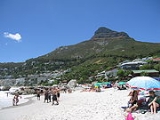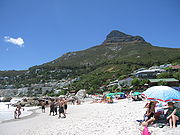
Clifton, Cape Town
Encyclopedia

Cape Town
Cape Town is the second-most populous city in South Africa, and the provincial capital and primate city of the Western Cape. As the seat of the National Parliament, it is also the legislative capital of the country. It forms part of the City of Cape Town metropolitan municipality...
, South Africa
South Africa
The Republic of South Africa is a country in southern Africa. Located at the southern tip of Africa, it is divided into nine provinces, with of coastline on the Atlantic and Indian oceans...
.
It is an exclusive residential area and is home to some of the most expensive real estate in South Africa, with dwellings nestled on cliffs that have sweeping views of the Atlantic Ocean.
The area has a set of 4 beach
Beach
A beach is a geological landform along the shoreline of an ocean, sea, lake or river. It usually consists of loose particles which are often composed of rock, such as sand, gravel, shingle, pebbles or cobblestones...
es which are frequently used destinations for both locals and tourists
Tourism
Tourism is travel for recreational, leisure or business purposes. The World Tourism Organization defines tourists as people "traveling to and staying in places outside their usual environment for not more than one consecutive year for leisure, business and other purposes".Tourism has become a...
. The beaches, which are named from 1st to 4th, are separated by falls of granite
Granite
Granite is a common and widely occurring type of intrusive, felsic, igneous rock. Granite usually has a medium- to coarse-grained texture. Occasionally some individual crystals are larger than the groundmass, in which case the texture is known as porphyritic. A granitic rock with a porphyritic...
boulders and have almost pure white granitic sand. The four beaches of Clifton are one of the few areas well protected from the notorious south-easterly wind, which has a great deal to do with its popularity with bathers. A fifth beach, before First Beach, called Moses Beach (so-called because of the papyrus plants that grow along it), appears and disappears as the sand is washed in and out with the seasons. The water, although chilly (12–16 °C), plays host to many watersports, mostly surfing, both board and body. The strongest surf is at First, diminishing to Fourth, where it is the weakest. Fourth beach (to the South), is the most populated and glamorous venue; attracting families. Yachts anchor off Fourth beach, especially on summer weekends. Third beach attracts gay men. Second beach is populated by students playing beach volleyball and beach bats. First beach, to the north, the smallest beach, draws a mixed crowd of locals and surfers (although Beach Bat tournaments have been held frequently here, with the current champions being team "PE to CT", consisting of Galia D and Jason G). Clifton Beach was noted as one of Discovery.com's best beaches by region.
Clifton's 4th beach has also been awarded the Blue Flag award
Blue Flag beach
The Blue Flag is a certification by the Foundation for Environmental Education that a beach or marina meets its stringent standards.The Blue Flag is a trademark owned by FEE which is a not-for-profit, non-governmental organisation consisting of 65 organisations in 60 member countries in Europe,...
in recognition of its environmental, safety and tourist standards.
The small size of the properties on which bungalows are built between Fourth and Second beaches is attributable to the fact that the area was laid out by the City of Cape Town for returning soldiers who had fought in World War I. The original bungalows, now all but replaced by new structures, were built from the packing cases that conveyed imported motor cars during the 1920's and '30's. Narrow flights of stairs run between Victoria Road and the various beaches. These houses now fetch very high prices on the housing market, despite being only able to be reached by stairs, and, in most cases, having no garaging.
Clifton was rated as one of the Top Ten Beaches by the cable and satellite television network Discovery Travel Channel
Discovery Channel
Discovery Channel is an American satellite and cable specialty channel , founded by John Hendricks and distributed by Discovery Communications. It is a publicly traded company run by CEO David Zaslav...
in 2003 and 2004 and has received Blue Flag status. In 2005 and 2006 it was rated by Forbes.com at number 8 in the Top 10 Topless beaches in the World.
An interesting feature of Clifton's 4 beaches involves the water temperatures and annual denudation and re-deposit of the bay's sugar-white sands, although for the most part protected in the 'wind shadow' of Lion's Head mountain that stands behind Clifton (on its Eastern side).
The strong prevailing south-east wind of summer (October to April), being off-shore, moves the warmer top layer of water out of the bay – with the result that a compensating strong inflow of icy cold water is set up into the bay. This tends to make water temperatures in summer dip to their lowest levels – sometimes below 10 C. It also has the effect of re-depositing sand (stripped in winter) onto the beaches, so that by late summer, Clifton's beaches are at their widest, allowing for easy pedestrian movement along the waterline, from beach to beach.
By contrast, winter's howling north-west gales drive warm surface-water into the bay, setting up a compensating outflow of water along the bottom. This water movement tends to cause the bay (and most of the adjacent Atlantic Seaboard) to fill with relatively warm water (10 - 20°C) during winter – but also strips the sand from the beaches, causing temporary beach erosion that exposes the granite boulder headlands that define the beaches. This peculiarity often startles those unaccustomed to the regular cycle; during these periods, city officials have been known to petition to have sand dumped on the Clifton shore to rectify what they perceive as a defect. But, each summer, Clifton repairs itself with new sand.
Clifton has had at least two separate shark attacks:
1) During 1942, Johan Christian Bergh was attacked by a shark 30 meters off of 4th beach. Mr. Bergh's body was never recovered. Witnesses report seeing a 6 meter great white shark
Great white shark
The great white shark, scientific name Carcharodon carcharias, also known as the great white, white pointer, white shark, or white death, is a large lamniform shark found in coastal surface waters in all major oceans. It is known for its size, with the largest individuals known to have approached...
swim along the surf's backline and take Mr. Bergh in two rapid attacks. The attacks were so swift that Bergh did not have a chance to emit a sound – consequently, few witnessed the event.
2) On Saturday 27 November 1976, Jeff Spence, an 18-year old submariner in the S.A. Navy was attacked by a 3.5 meter great white while treading water
Treading water
Water treading is an aspect of swimming that involves a swimmer staying in a vertical position in the water while keeping his or her head above the surface of the water...
100m from 4th beach. Mr. Spence suffered significant trauma to the left side of his torso – with deep punctures and gouges back and front. Being an extremely hot day, no fewer than 6 doctors were on the beach at that time, and, together with the efforts of volunteer lifesavers from Clifton Lifesaving Club, Spence survived and was airlifted to hospital where he made a full recovery.
The attacks notwithstanding, shark sightings are extremely rare in Clifton and on the Atlantic coast in general. Most supposed sightings turn out to be seals or sunfish
Sunfish
-Saltwater fishes:*Molidae, family of Ocean Sunfishes*Opah, family Lampridae; two species-Freshwater fishes:* Pygmy sunfish, six members of the genus Elassoma* Centrarchidae, a perciform family of about 27 species...
.

